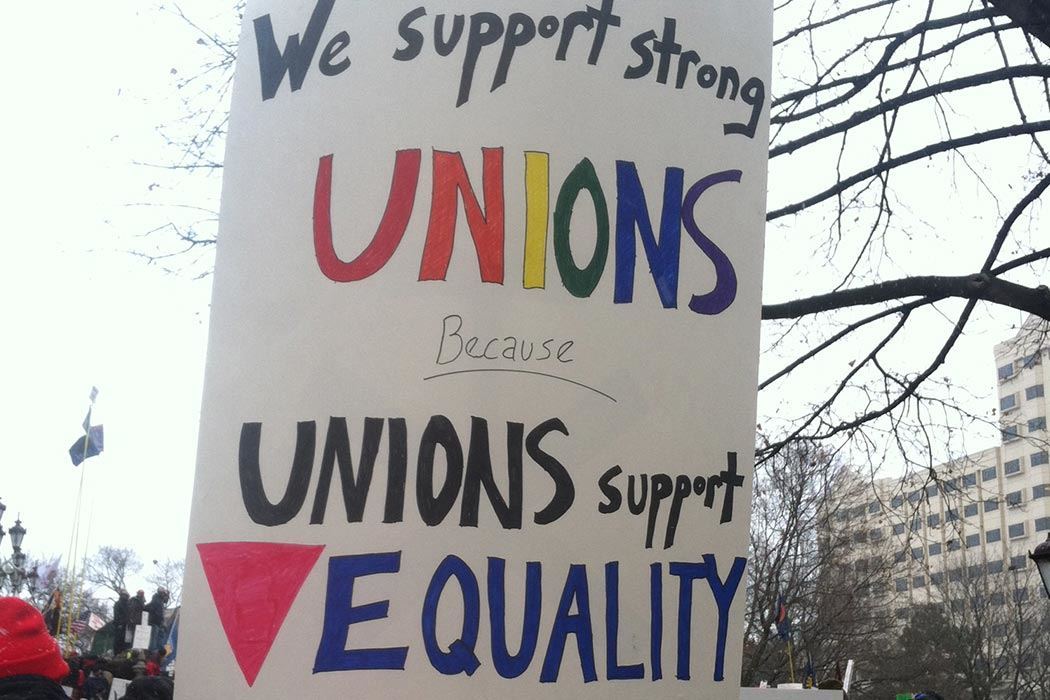During the Great Depression, the general public was resistant to the hard-line, pro-industry stance of the National Association of Manufacturers. Even the U.S. Chamber of Commerce president Eric Johnston went so far as to admonish the association in a speech to manufacturers in 1943:
Only the willfully blind can fail to see that the old-style capitalism of a primitive, free-shooting period is gone forever,” he told the business elite. “The capitalism … which thrived on low wages and maximum profits for minimum turnover, which rejected collective bargaining and fought against justified public regulation of the competitive process is a thing of the past.
Manufacturing executives were hardly swayed by Johnston. These were men whose predecessors had fought aggressively against unions since the association’s founding in 1895. But they did realize they would need to make their case against New Deal reforms in more subtle ways if they were to garner popular support. One way to sell their message to average Americans was through public relations.
The National Association of Manufacturers produced a nationally syndicated television program, Industry on Parade, which ran from 1950 to 1960 and was distributed to schools and community organizations for free. It even won a Peabody. The message: America has the highest standard of living in the world because our individual freedoms spur innovation, which in turn lead to sales of new and better products to markets around the globe. Without saying so directly—a strategy that had backfired during the Great Depression—they were promoting corporate paternalism, the system big business had said was in everyone’s best interest before the stock market crash of 1929. Their aim was an economy unencumbered by government regulation and organized labor.
One of the chief architects of the public relations campaign was candy manufacturer Robert Welch, inventor of the Sugar Daddy and eventual founder of the John Birch Society in 1958. When the group had its first meeting, only fellow National Association of Manufacturers board members were invited to attend. These men were united by a shared sense that their power had been eroded by New Deal initiatives and the suspicion that President Dwight Eisenhower was a Communist. Among the business leaders in attendance was Fred Koch, a chemical engineer from Texas who had founded an oil refinery firm that later became Koch Industries. Today, Koch Industries is the second largest privately held company in the U.S., and, since Fred Koch’s death in 1967, run by his sons Charles and David, commonly referred to as the Koch brothers.
The founders of the John Birch Society argued government regulation of business activity was a form of coercion, that the income tax should be illegal, and that Social Security was tantamount to theft. The Koch brothers are now synonymous with the worldview first touted by their father and his like-minded manufacturers, and the original philosophies of the John Birch Society have become rallying cries in certain corners of American politics. Watch a Republican presidential debate, and you’ll see they’re hard to miss. And if you look back at the career of erstwhile GOP candidate Scott Walker and two-time Wisconsin governor, you’ll find a politician who has based his career on the very slogans and rhetoric put out by the powerful manufacturers of the 1950s and ’60s.
Scott Walker, who rode the 2010 Tea Party wave into office, first gained national attention in 2011 after he limited the collective bargaining rights for most public employees. Enemies of public sector unions had waited decades for this moment, according to historians Steve Fraser and Joshua B. Freeman. It was an ironic one for the state that, in 1959, became the first to pass a law granting the right to collectively bargain.
The number of union workers has been on the decline for decades, but union members did once represent the strongest and most reliable Democratic voting bloc in the country. Today, union members still vote predominantly Democratic, and that’s why the gutting of unions has come as a victory for social conservatives striving to defund the Democratic Party. Their demise has also come as welcome news to Tea Partiers who seek to chip away at the strength and size of government.“Unions hamper the disassembly of the state: layoffs, agency closures, budget cuts, privatization, and the elimination of welfare benefits. So unions have to go,” explain Fraser and Freeman. There’s also the influence of Biblical capitalism, which has long promoted the notion that the Bible endorses free enterprise and abhors socialism. The first executives in the National Association of Manufacturers argued unions were in open warfare against Christianity.
The History of Anti-Union Legislation
The piece of legislation business executives of the Great Depression era fought hardest against was the 1935 National Labor Relations Act, better known as the Wagner Act. Set against the backdrop of the roiling labor disputes of the early 1930s, the Wagner Act established the legal right of most workers to organize or join labor unions and to bargain collectively, while also forbidding employers from discriminating against workers who organized. The federal government became the regulator and arbiter of labor relations via a permanent National Labor Relations Board. Republicans, big business, and the manufacturers association fought back, winning significant gains 12 years later with the Taft-Hartley Act of 1947. Taft-Hartley repealed portions of the Wagner Act and outlawed the “closed shop,” a system where only union members were hired.. In effect, this guaranteed laborers the right not to join unions, and it made restricting employment to only union members illegal. Taft-Hartley also gave states the ability to enact “right to work” laws, a euphemistic term granting opponents of unions the ability to institute open-shop laws in which workers are hired without regard to union membership.
The conservative point of view is generally that “right to work” laws guarantee that laborers “cannot be compelled to financially support a union they don’t wish to join,” and they often use the rhetoric of personal liberty to underscore their argument. The unions counter that because federal law mandates that unions must represent all workers, even those workers who do not belong to the union or pay for such representation, “right to work” laws both create freeloaders and significantly lessen the ability of unions to lobby for their rights.
To date, there are 25 states with “right to work” laws in place, and “while the most highly publicized and significant changes have taken place in Wisconsin, radical revisions of public-sector labor-relations law and policy have been afoot in … Indiana, Michigan, Ohio,” and elsewhere, writes political scientist Étienne Cantin in “The Politics of Austerity and the Conservative Offensive Against U.S. Public Sector Unions, 2008-2012.” In 2014, in what has been called one of the most anti-union decisions in years, the Supreme Court ruled in Harris v. Quinn, by a 5-4 margin, that the Public Labor Relations Act in Illinois violated the First Amendment in its use of union security agreements. The National Right to Work Legal Defense Foundation, a group closely aligned with the Koch brothers, had sued on behalf of eight home health care workers, arguing that agency fees (dues paid by nonunion members to unions) were unconstitutional. Since then, there has been much discussion about whether the Supreme Court will nationalize the “right to work” ideology, potentially heralding the undoing of unions.
In a message from September 2010 on Koch Industries letterhead, Charles Koch, sounding very much like Robert Welch writing with worry to his fellow National Association of Manufacturers board members, invited a group of powerful insiders to a private seminar in Palm Springs titled Understanding and Addressing Threats to American Free Enterprise and Prosperity. This was just before the 2010 midterm elections in which the Tea Party won control of the U.S. House of Representatives and made significant gains in the Senate. Koch wrote, “From the nationalization of health care to the rising power of unions, as well as a push for major new climate and energy regulations, financial regulation, and even more government spending, there is no lack of significant threats for us to understand and address.”
During Scott Walker’s 2010 run for governor, the Koch brothers contributed $43,000 to his campaign, the largest out-of-state contribution he received. Koch Industries–funded organizations like Americans for Prosperity and Club for Growth bussed in thousands of Tea Party members to support Walker during the effort to recall him in 2012, in response to his moves to limit public-sector unions. Walker beat them back successfully and won again in 2014. And on July 13 of this year, he announced his bid to become the next Republican president. Although he’s now dropped out of the race, the Koch brothers were ready to spend nearly $1 billion in the 2016 presidential campaign cycle.







